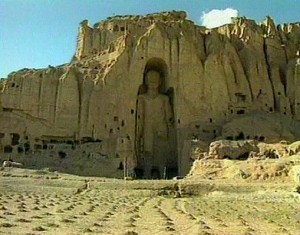· The name “Afghanistan” comes from “Upa-Gana-stan” which means in Sanskrit “the place inhabited by allied tribes”.
· This was the place from where Gandhari of the Mahabharat came from, Gandhar whose king was Shakuni. The Pakthoons are descendants of the Paktha tribe mentioned in Vedic literature. Till the year 980 C.E., this area was a Hindu majority area, till Sabuktagin from Ghazni invaded it and displaced the ruling Hindu king – Jaya Pal Shahi.
· There was a time when the entire region was replete with hundreds of Shiva temples celebrating Shiva – Parvati worship and abuzz with Shiv chants, prayers, legends and worship. Archaeological excavations in this region conducted by Sir Estine (an East India Company official) led to the recovery of uncountable shrines and inscriptions. He has authored four books on that topic featuring photos of icons, icons and inscriptions discovered. The photos show a sun temple and a Ganesha statue too. An Islamabad University professor Abdul Rehman has authored two books on those finds recalling the glory and prosperity of those times. Regimes of two Hindu rulers “Kusham” and “Kidara” lasted for fairly long periods.
· During their rule a number of Shiva temples were not only inAfghanistan but in other West Asian regions too. Uzbekistan and Takzikistan formed part of the Afghan kingdom in those times. Tashkent has one of those ancient Shiva temples standing even today.
· “Kalhan“, the ancient Hindu historian of Kashmir has mentioned that the army of the then Hindu ruler of Kashmir had a battle with a vast army of the Arab Khalifa Mamoon whose headquarters was Baghdad. At that time Bukhara had been under Muslim rule. He had invited a number of leading Hinduexperts to Baghdad.
· An Ayurvedic practitioner of Varansi (alias Benares) had treated the Khalifa for some ailment afflicting the latter. In those days it was Hindu Ayurvedic practitioners who were eagerly sought by Arab patients. A number of Arabs had translated Sanskrit Ayurvedic texts into Arabic. A list of those translated Sanskrit texts appears in a Volume known as al “Frisht“.
· Baku (capital of the Azerbaijan region) known for its underground petroleum yields has still an ancient Hindu temple of the Divine Flame generated by the subterranean petrol and gas). During the Czar regimes in Russia a Punjabi priest officiated at that temple.
· The walls display some religious stanzas written in Punjabi Gurumakhi script. The market there also had Hindu merchants. Nearby was a locality too of Hinduinhabitants. Baku in Azerbaijani language actually signifies a Goddess. Therefore obviously Baku derives its name from a very ancient Vedic Goddess temple there.
· Kenduj a province of Afghanistan, ruled by a king that had a Hinduprime minister. This is mentioned in history books. Albirruni’s travel account contains details of ancient Hindu Afghanistan, He mentions aHindu king, Khingla whose coins bore the imprint of Shiva.
· When Hsüan-tsang visited the region early in the 7th century CE, the Kabul valley region was ruled by a Hindu Kshatriya king, who is identified as the Shahi Khingal, and whose name has been found in an inscription found in Gardez.
· The place where Kabul’s main mosque stands today was the site of an ancient Hindu temple and the story of its capture is kept alive in IslamicAfghan legend which describes the Islamic hero Sabuktagin who fought with a sword in every hand to defeat the Hindus and destroy their temple to put up a Mosque in its place.
· The recovery and significance of the inscription, telling a story of the Hindu ruler Veka and his devotion to lord ‘Siva’, was told by leading epigraphist and archaeologist Prof Ahmad Hasan Dani of the Quaid-E-Azam University of Islamabad at the ongoing Indian History Congress here.

4 Responses to “Hindu History of Afghanistan”